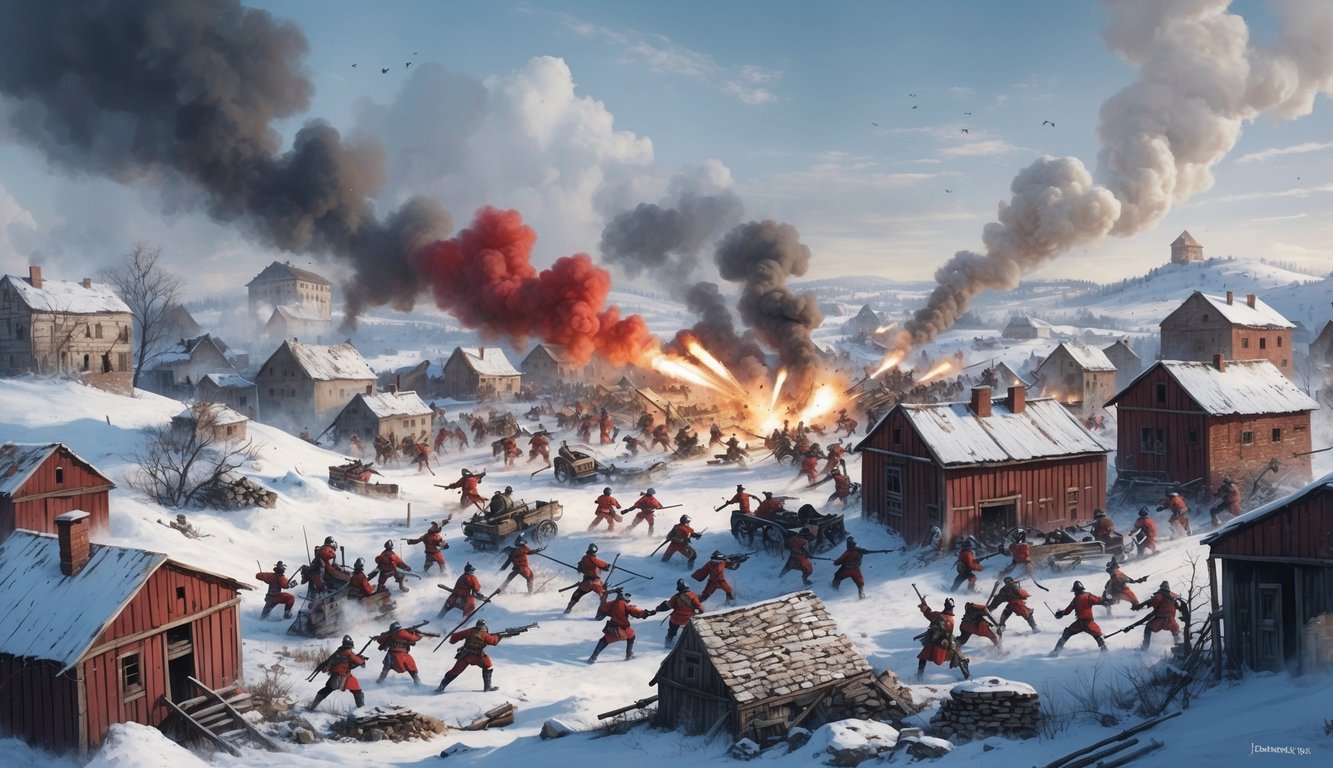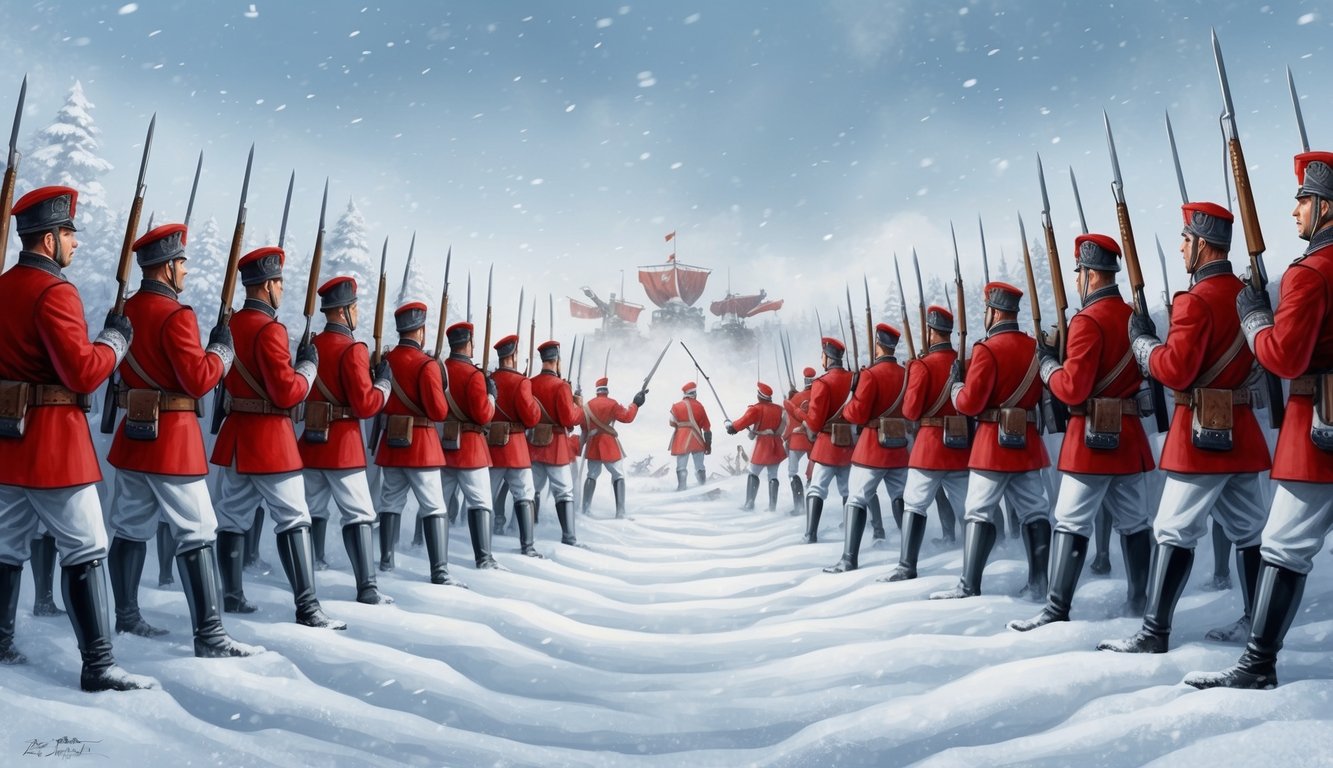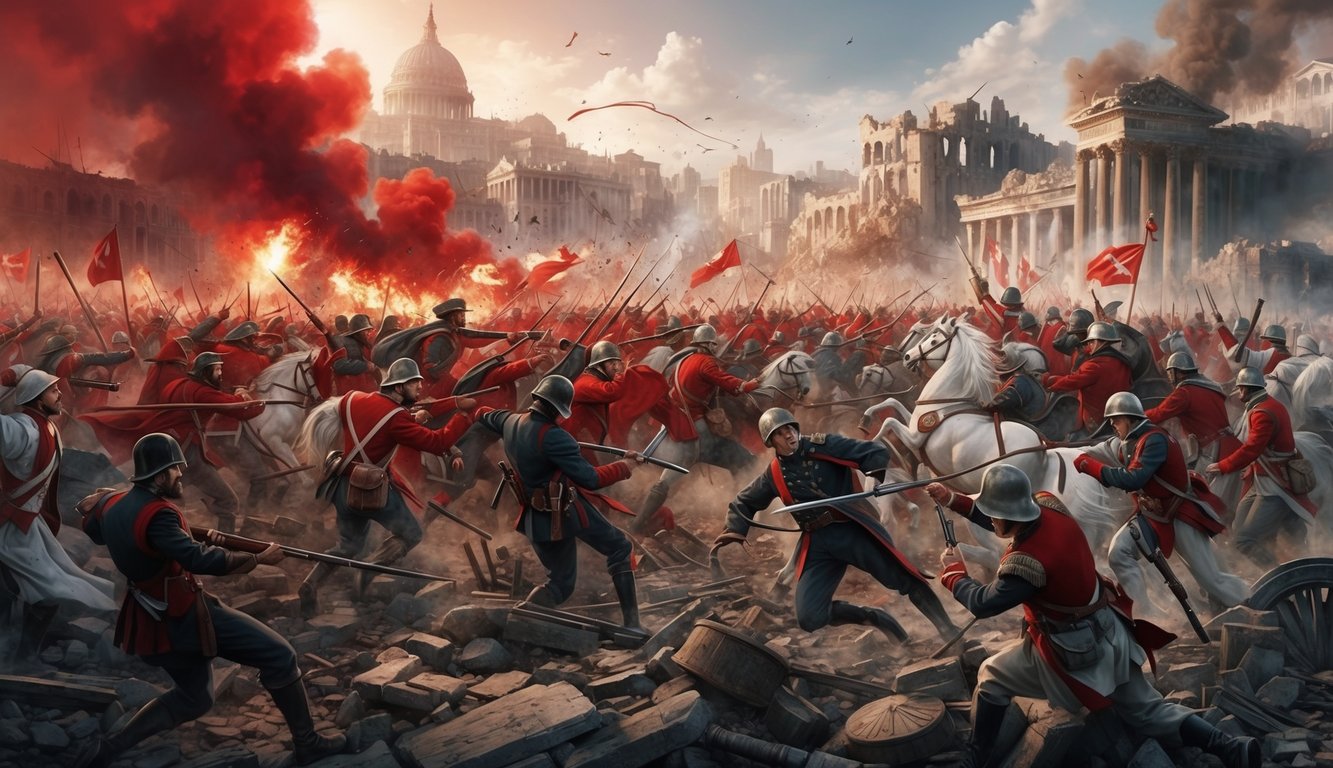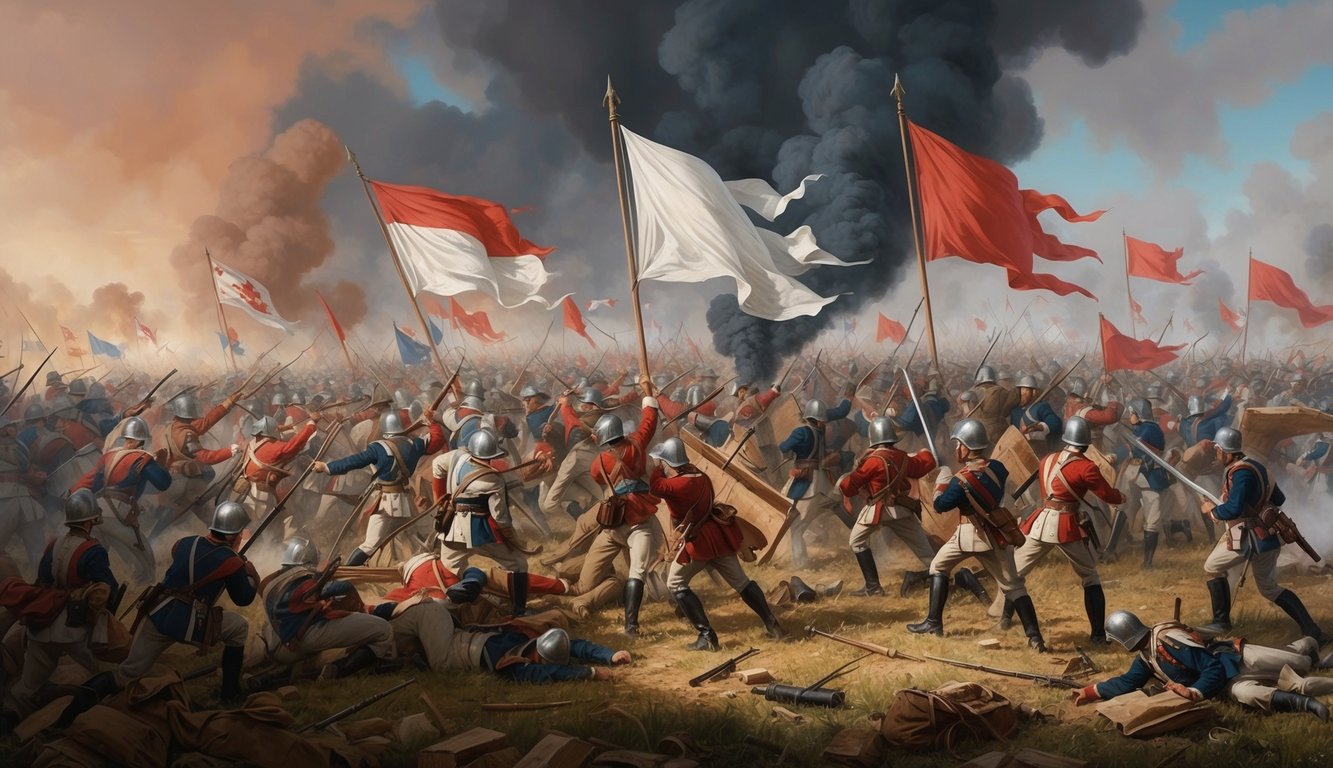The Russian Revolution and Civil War from 1917 to 1923 significantly transformed the political landscape of Russia and reverberated throughout the globe.
This historical period can be viewed as a confrontation between two opposing ideologies represented by the “Reds” and the “Whites.” The Reds, spearheaded by the Bolsheviks under Vladimir Lenin, aimed to establish a communist state, while the Whites, a loose alliance of various groups, were determined to uphold aspects of the old regime.
The struggle escalated from a revolutionary movement to a full-blown civil war, plunging the former Russian Empire into chaos and violence. Within this tumultuous era, you’ll learn how the Bolsheviks rose to power during the October Revolution, igniting resistance from multiple factions.
This conflict saw the Red Army clashing with White Army forces across expansive territories.
Key historical figures emerged during this time, including Leon Trotsky, who organized the Red Army, and notable White commanders like Anton Denikin.
The civil war’s outcome not only determined the future of Russia but also had substantial implications for global politics for years to follow.
By exploring this intricate historical chapter, you’ll gain valuable understanding of the forces that led to the inception of the Soviet Union.
Key Takeaways
- The Russian Revolution initiated a civil war between the communist Reds and the anti-communist Whites
- This conflict redefined Russia’s political framework and had significant worldwide repercussions
- Prominent figures such as Lenin and Trotsky played vital roles in the Bolshevik triumph and the establishment of the Soviet state
Prelude to Revolution
The years preceding the Russian Revolution were characterized by social unrest, political upheaval, and the burdens of World War I. These elements converged to create a highly volatile environment that ultimately led to the collapse of the Romanov dynasty and laid the groundwork for revolutionary change.
The Fall of the Romanovs
Surprisingly, the Romanov dynasty had ruled Russia for over 300 years before its dramatic decline in 1917.
Tsar Nicholas II, the last of the Romanovs, faced immense pressure from a populace weary of autocratic governance and economic distress.
His reign was perceived as weak and disconnected from the people’s struggles.
His wife’s German ancestry and her influence on him further fueled public discontent, while the enigmatic figure of Rasputin contributed to the royal family’s mistrust among the population.
As public dissatisfaction deepened, calls for change gained traction.
The Tsar’s efforts to cling to absolute power only intensified the revolutionary fervor.
The February Revolution and the Provisional Government
In February 1917, the streets of Petrograd (now St. Petersburg) erupted in chaos.
Workers initiated strikes, and soldiers began siding with the demonstrators.
The February Revolution compelled Tsar Nicholas II to abdicate, marking the end of centuries of Romanov rule.
A Provisional Government emerged, led by liberal politicians, but struggled to effectively tackle the nation’s pressing issues.
It shared authority with the Petrograd Soviet, leading to a system known as “Dual Power.”
Although the Provisional Government enacted some reforms, it decided to persist in Russia’s involvement in World War I—a decision that would prove disastrous.
Impact of World War I
The significance of World War I in leading to the Russian Revolution cannot be understated.
The war overwhelmed Russia’s economy and people, resulting in food shortages, arms deficits, and general discontent at the front.
At home, you would have witnessed rising food prices and severe shortages.
The war revealed the inefficiencies entrenched in the Russian government and military.
Military losses demoralized the populace and diminished support for the Tsar, with growing calls for peace.
The Provisional Government’s choice to continue the conflict contributed to its eventual downfall and set the stage for the Bolshevik Revolution.
The Bolshevik Rise to Power
The Bolsheviks’ ascent to power was driven by strategic maneuvers, revolutionary zeal, and the dynamic leadership of Vladimir Lenin.
Their principles and actions drastically altered Russia’s political landscape in 1917.
Vladimir Lenin and Bolshevik Ideals
Vladimir Lenin, the chief architect of the Bolshevik movement, advocated for radical transformation in Russia.
His vision revolved around empowering workers and dismantling the existing government structure.
Interestingly, Lenin spent years in exile refining his revolutionary ideology.
The Bolsheviks, a faction within the Russian Social Democratic Labour Party, aimed for immediate revolution, standing out for their commitment to a tightly-knit party leading the working masses to power—contrasting with other socialist factions that preferred a more gradual approach.
Lenin’s famous slogan, “Peace, Land, and Bread,” struck a chord with war-weary Russians, promising to end World War I, redistribute land to peasants, and provide food for the populace.
This simple yet impactful message garnered significant public backing for the Bolsheviks.
The October Revolution
The October Revolution, or Bolshevik Revolution, represented a crucial turning point in Russian history.
On November 7, 1917 (October 25 in the Julian calendar), the Bolsheviks took control of Petrograd (now St. Petersburg).
Under the leadership of Lenin and Leon Trotsky, the Red Guards assaulted vital government facilities, with the Winter Palace—home to the Provisional Government—falling with minimal resistance.
You might be astonished by how swiftly and nearly bloodlessly this coup occurred.
The Bolsheviks’ success hinged on their mastery of key strategic locations:
- Railways
- Post offices
- Telegraph stations
By commanding these assets, they effectively disrupted communication and transportation for their adversaries, showcasing precise planning and organizational skills.
Establishment of Bolshevik Government
After securing Petrograd, the Bolsheviks rapidly endeavored to consolidate their power.
Lenin assumed leadership of the new government, designated the Council of People’s Commissars.
Notably, this council issued several significant decrees within days:
- The Decree on Peace: Called for an immediate exit from World War I
- The Decree on Land: Abolished private property and redistributed land to the peasantry
- The Declaration of Rights of the Peoples of Russia: Ensured equality and sovereignty for all ethnic groups
Despite facing opposition from various entities collectively labeled as the Whites, the Bolsheviks persevered, ultimately establishing the Soviet Union.
Lenin’s stewardship was pivotal during this tumultuous period.
His ability to adapt Marxist theory to Russian realities, coupled with a practical governance approach, helped the Bolsheviks withstand the adversities of civil war and foreign interference.
Civil War Outbreak
The Russian Civil War ignited in 1918, pitting the Bolshevik Red Army against several anti-Bolshevik factions.
This conflict would leave a lasting imprint on Russia’s future and reverberate across the globe.
Factions and Initial Conflicts
On one side of this fierce conflict stood the Red Army, backed by the Bolsheviks, determined to defend their newly established socialist government.
Conversely, the White Army emerged as a loose coalition of anti-Bolshevik factions, consisting of former Tsarist officers, conservatives, and moderate socialists.
Hostilities intensified when the Czechoslovak Legion, stranded in Russia, clashed with Bolshevik forces along the Trans-Siberian Railway.
This confrontation sparked widespread rebellion against Bolshevik authority.
Significant battles erupted throughout the former Russian Empire, with the Whites initially gaining ground in Siberia and southern Russia.
Nonetheless, the Reds maintained control over the industrialized central regions, granting them a strategic edge.
Foreign Intervention and Support
You might find it surprising that a number of foreign nations intervened in the Russian Civil War.
Allied nations like Britain, France, and the United States dispatched troops and supplies to bolster the White forces, primarily to revive the Eastern Front against Germany during World War I.
Japan also seized the opportunity to expand its influence in the Russian Far East.
These foreign interventions complicated the conflict and prolonged the hostilities.
The Allies provided the Whites with military support, advisors, and economic assistance.
However, their backing was often inconsistent and poorly coordinated, which ultimately hampered the White Army’s effectiveness.
The Role of the Cheka and Terror Tactics
You shouldn’t overlook the significant role played by the Cheka, the Bolshevik secret police, during the Civil War.
Established by Felix Dzerzhinsky, the Cheka evolved into a critical instrument for quelling opposition to Bolshevik rule.
The Cheka executed the Red Terror, a campaign involving mass arrests, deportations, and executions aimed at suspected enemies of the revolution.
This brutal strategy sought to eradicate political adversaries and instill fear within the populace.
In retaliation, White forces initiated their terror campaign known as the White Terror, which included pogroms against Jewish communities and retaliatory acts against presumed Bolshevik supporters.
These terror strategies exacerbated the war’s brutality and left deep psychological scars on the Russian populace.
Major Battles and Campaigns

The Russian Civil War was characterized by several vital fronts and military campaigns that determined the conflict’s outcome.
These battles involved numerous factions and foreign interventions, occurring across the vast expanse of Russian territory.
The Eastern Front and Admiral Kolchak
You might be intrigued to learn that one of the most decisive campaigns unfolded in Siberia.
Admiral Kolchak, headquartered in Omsk, led the White forces on the Eastern Front.
His early successes pushed the Bolsheviks back, coming perilously close to the Volga River.
Kolchak’s troops captured Perm and Ufa, posing a threat to Moscow.
However, the situation shifted in 1919.
The now better-organized Red Army launched a counteroffensive, forcing Kolchak’s forces into retreat.
By late 1919, Kolchak’s army was in full flight.
They abandoned Omsk and fled eastward along the Trans-Siberian Railway, culminating in Kolchak’s capture and execution in early 1920.
The Southern Front and the Volunteer Army
In the south, the Volunteer Army emerged as the principal White force.
They embarked on the audacious “Ice March” from Rostov-on-Don to the Kuban region, preserving the White movement’s core in the southern territory.
Led by Generals Denikin and Wrangel, the Volunteer Army advanced northward, capturing Ukraine and pushing towards Moscow in 1919.
Major cities like Kyiv fell to the Whites.
However, their advance faltered near Orel, where the Red Army counterattacked, forcing a retreat.
Ultimately, the Whites retreated to Crimea, and Wrangel conducted a final stand there before evacuating in 1920.
The Role of the Czechoslovak Legion
You may wonder how the Czechoslovak Legion influenced the conflict.
These former Austro-Hungarian POWs fought their way across Russia in a bid to reach Vladivostok.
The Legion’s uprising in 1918 incited anti-Bolshevik revolts along the Trans-Siberian Railway, capturing crucial cities like Samara and Vladivostok.
This bolstered the Whites’ control in Siberia.
The presence of the Legion constrained significant Red Army forces, securing Kolchak’s rear and facilitating Allied involvement in Siberia.
By 1920, most Legion members had been evacuated via Vladivostok, marking their exit from the war.
Key Figures and Leaders

The Russian Civil War brought forth a plethora of influential figures on both sides.
These leaders significantly shaped military strategies, political ideologies, and ultimately the conflict’s resolution.
Strategic Minds: Trotsky and Red Military Leadership
Leon Trotsky was instrumental in the Red Army’s triumph.
As People’s Commissar for Military and Naval Affairs, he transformed a disorganized unit into a powerful military force.
Despite lacking previous military experience, Trotsky employed innovative tactics, including utilizing former Tsarist officers as military specialists.
Trotsky excelled in rallying troops and famously commanded an armored train that enabled rapid movements between fronts.
His strategic acumen and organizational prowess were essential in turning the tide against White forces.
White Commanders and their Strategies
The White movement featured several notable leaders, each employing their strategies against the Bolsheviks.
Anton Denikin, a former Tsarist general, commanded the Volunteer Army in southern Russia.
He initially achieved significant early victories but found it challenging to sustain momentum.
Following Denikin, Pyotr Wrangel, dubbed the “Black Baron,” took charge in 1920, attempting land reforms to garner peasant support.
Unfortunately, it was too little, too late for the war’s trajectory.
Meanwhile, in Siberia, Admiral Alexander Kolchak declared himself “Supreme Ruler of Russia,” spearheading an offensive toward Moscow.
However, his authoritarian demeanor alienated potential collaborators.
Other Influential Personalities
Nestor Makhno, an anarchist revolutionary, led the “Black Army” in Ukraine, combating both Red and White forces and carving out a unique “third force” in the conflict.
Alexander Kerensky, the last Prime Minister of the Russian Provisional Government, initially opposed the Bolsheviks but found himself increasingly sidelined as the Civil War progressed.
Out east, Grigory Semyonov, a Cossack ataman, established a semi-autonomous domain, though his ruthless administration and collaboration with Japanese forces ultimately hindered the White cause in that region.
These diverse leaders and their competing visions for Russia’s future added layers of complexity and violence to the Civil War.
International Relations and Treaties

The Russian Revolution and Civil War had significant ramifications for international relations.
Foreign powers became heavily involved in the conflict, influencing its trajectory and outcome through various treaties and interventions.
The Treaty of Brest-Litovsk and Its Implications
In March 1918, the Treaty of Brest-Litovsk dramatically altered Russia’s position by concluding its involvement in World War I. The Bolsheviks consented to harsh conditions, surrendering extensive territories to the Central Powers.
This treaty resulted in Russia losing:
- 34% of its population
- 32% of its agricultural land
- 54% of its industrial land
The loss of resources and territory diminished the new Soviet state, inciting anger among many Russians and intensifying opposition to the Bolsheviks during the civil war.
The Allies and Their Role in the Civil War
Western Allies, including Britain, France, and the United States, dispatched troops and provided supplies to support the White forces.
Their motivations were multifaceted:
- Fears of Bolshevism spreading
- The desire to ensure Russia’s continued participation in World War I
- Protection of Allied military assets in Russia
Allied intervention unfolded in varying forms:
- British forces operating in North Russia and the Caucasus
- American and Japanese deployments in Siberia
- French support in Ukraine and Crimea
Despite being substantial, Allied support ultimately proved insufficient to turn the tide for the Whites.
By 1920, most foreign forces had retreated, allowing the Bolsheviks to consolidate their hold.
Aftermath and Legacy
The Russian Civil War left a profound impact, reshaping Russia and influencing global dynamics for decades to come.
The Establishment of the Soviet Union
The Bolshevik triumph culminated in the formation of the Soviet Union in 1922.
A new governance system emerged, led by the Communist Party, resulting in a one-party state that embraced socialism while renouncing the tsarist legacy.
Lenin’s New Economic Policy reintroduced limited private enterprise to aid in rebuilding the war-torn economy, yet Stalin’s ensuing reforms would advocate for aggressive industrialization and agricultural collectivization.
The new regime confronted the challenge of unifying the sprawling territories and diverse populations of the former Russian Empire, establishing a federal structure that offered nominal autonomy to various ethnic regions.
Effects on Russian Society and Economy
The devastation inflicted by the civil war was staggering.
The loss of life numbered in the millions, with countless fatalities resulting from combat, disease, and famine.
The country’s infrastructure bore the scars, with factories devastated and farmland left uncultivated.
The Bolsheviks implemented radical societal shifts:
- Abolition of the aristocracy
- Redistribution of land to peasants
- Expansion of women’s rights
- Promotion of atheism
Education gained prominence, leading to widespread literacy campaigns.
Under state patronage, the arts experienced a revival, although creative freedom was often curtailed by political constraints.
International Impact
The ramifications of the Russian Civil War echoed globally.
The establishment of the first socialist state inspired leftist movements worldwide.
In response, the Communist International (Comintern) was created to propagate revolution internationally.
Western nations, wary of the spread of communism, embraced containment strategies.
This ideological divide laid the groundwork for the Cold War, significantly affecting international relations for many years.
Furthermore, the Polish-Soviet War of 1919-1921 arose from the civil war’s aftermath as Poland sought to extend its reach eastward while Soviet forces advanced westward.
Ultimately, the formation of the USSR shifted the balance of power across Europe and Asia, giving rise to a new superpower that would challenge Western influence throughout the 20th century.
Frequently Asked Questions
The Russian Civil War was a multifaceted conflict marked by several key figures, motivations, and pivotal moments.
Foreign interventions and propaganda were instrumental in shaping its outcome and the subsequent evolution of Soviet Russia.
Who were the key figures leading the Red and White forces during the Russian Civil War?
The Red Army, representing the Bolsheviks, was led by Vladimir Lenin and Leon Trotsky, with Trotsky organizing and commanding the Red forces in his role as People’s Commissar for Military Affairs.
On the White side, significant leaders included Anton Denikin, Alexander Kolchak, and Pyotr Wrangel, each commanding distinct White armies across various Russian regions.
What were the primary reasons behind the Russian Civil War?
The Bolshevik takeover during the October Revolution of 1917 incited civil conflict.
Various groups opposed the new communist rule, including monarchists, liberals, and moderate socialists.
Economic instability and food shortages fueled widespread discontent, while the Bolshevik exit from World War I alienated many Russians who perceived it as a betrayal.
How did the foreign interventions impact the outcome of the Russian Civil War?
Multiple foreign powers intervened in the conflict, primarily rallying behind the White forces.
Britain, France, and the United States provided troops and resources to support the anti-Bolshevik factions.
These interventions prolonged the conflict but ultimately failed to subdue the Reds.
The foreign military presence also helped unify many Russians behind the Bolsheviks, who positioned themselves as defenders against foreign aggression.
What were the major battles or turning points in the Russian Civil War?
The Battle of Tsaritsyn in 1918 represented a crucial victory for the Reds, ensuring their control over the Volga River with Joseph Stalin’s involvement enhancing his reputation during this engagement.
The decisive defeat of Admiral Kolchak’s forces in Siberia in 1919 signified a major turning point, enabling the Reds to redirect their focus to other fronts and ultimately defeat the remaining White forces.
How did the outcome of the Russian Civil War influence the future of Soviet Russia?
The Bolshevik victory solidified their authority over Russia, culminating in the establishment of the Soviet Union in 1922.
This victory allowed for the implementation of their socialist policies and the consolidation of a one-party state.
The war’s devastation necessitated the New Economic Policy, which reintroduced some capitalist elements.
This recovery phase paved the way for Stalin’s subsequent industrialization initiatives.
In what ways did propaganda play a role in the success of either side in the Russian Civil War?
The Bolsheviks adeptly utilized posters, slogans, and films to advocate for their cause, framing themselves as the champions of workers and peasants against capitalist oppressors.
Their propaganda emphasized the foreign backing of the Whites, depicting them as instruments of Western imperialism, which fueled public support for the Bolshevik agenda.
Conversely, White propaganda focused on traditional Russian values and patriotism, but it proved less effective in rallying mass support compared to the Bolsheviks’ revolutionary narrative.

